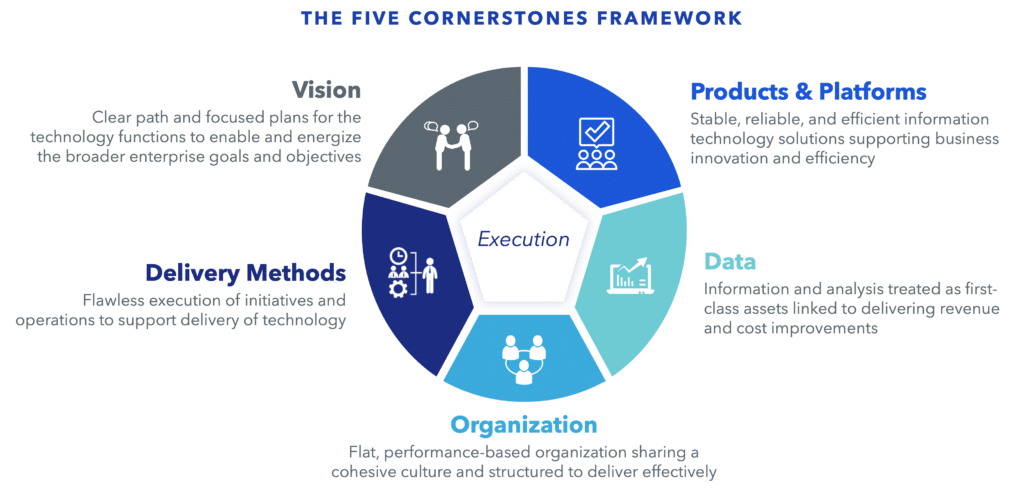As the digital landscape evolves at an unprecedented pace, the traditional separation of technology strategy from core business objectives becomes increasingly unreasonable. This shift reflects a deeper, proactive adaptation to the integral role of technology in shaping business strategies.
Through conversations with several CIOs and CTOs about how their worlds are evolving and what they see as critical for strategic planning for technology organizations going forward, combined with our experiences on dozens of projects with our clients, Pariveda has updated our approach and frameworks to address several questions that define the new landscape of Technology Strategy:
- Now that technology is so integral to overall business strategy, does it even make sense to have a separate technology strategy?
- What makes a great technology strategy today compared to past approaches?
- What’s the value leaders realize from completing these strategic efforts?
What is Technology Strategy today?
We have progressed significantly from the era when “Business/ IT Alignment” ranked as the top concern of CIOs. A couple of decades ago, most CIOs were just trying to get into the conversation about where their business was going so that they could build a strategy of support. Many IT organizations focused primarily on their internal customers and how they could be great service providers, responding to and prioritizing their many needs for new and evolved applications.
Over time, technology became a crucial component of overall business strategy across virtually every industry. As technology became more interwoven with strategic opportunities, CIOs secured their coveted seat at the decision-making table, or their companies established different roles, such as CTOs and CDOs, to fill that strategic advisory need. IT organizations tried to evolve to be more like software companies as more technology touched end customers, often directly driving revenue. If their IT organizations weren’t capable, some companies set up new organizations to build out their customer-facing technologies. As the scope of technology influence expanded, many companies and their consulting firms expanded IT Strategy to Technology Strategy, or in other cases, intentionally separated the two so that customer-facing technology was handled through distinct groups and strategies separate from internal systems.
Today, Pariveda broadly defines Technology Strategy as the guiding policies and coherent actions that drive the investments of the resources – both people and money – under the purview of the CIO or CTO. Our clients come to us with many needs that they consider part of Technology Strategy:
- Developing a comprehensive roadmap for systems to support some or all of the business
- Transforming the organization from project to product thinking – which involves culture work, organizational design, and people development
- Building the overall vision and plan for how their organization will contribute to their broader company’s objectives
How has Technology Strategy evolved over the years?
Based on insights gathered from discussions with industry leaders, as well from our work with our clients, we identified that several interrelated shifts have influenced almost every business and industry and changed how technology executives work with their peers to support organizational-wide objectives.
Technology’s integration with business strategy
These days, almost every business in nearly every industry considers technology a crucial part of the business strategy, not merely something that supports it after the strategy is decided. Someone bringing technical depth, usually the CIO or CTO, is now in the early conversations about strategic opportunities and threats, bringing ideas and innovations that drive where the company is going versus just responding to the desires of their leadership. Additionally, business leaders are more sophisticated about technology, bringing many ideas to the table themselves.
Shortening of the planning horizon
With how fast businesses and industries are changing and how responsive businesses must be to changing market conditions to be competitive, relying on a 5-year plan is simply not acceptable anymore. Technology executives must deliver value faster. While it is helpful to keep a longer horizon in mind for visioning where the organization and its technology will go, typically, only the next 12-18 months are crystalized, and three years out is more opaque. The planning itself is much more iterative and must be responsive to new developments.
Shift from project to product thinking
It used to be that the outcome of a strategic planning process was a set of approved business cases, each with detailed costs and benefits. These approved business cases would launch projects that were woven together on an overall roadmap. These days, the plan is often more about what platforms we should invest in versus what projects we should undertake. This shift has significant implications for IT’s processes and organizations as well.
Four reasons why Technology Strategy is still important
Some of the shifts described above may raise questions about whether Technology Strategy is even necessary anymore. If technology is so strongly represented as part of the overall business strategy, do we need a separate technology strategy? If longer planning horizons are unrealistic, won’t the analysis be outdated before we start working on the plan? If we are no longer planning and approving projects but rather making investment decisions in products or platforms, do we still need to go through the prioritization exercise often associated with strategic planning? Our perspective is yes, Technology Strategy is still necessary, but the focus is different. Here are four reasons why a Technology Strategy is needed.
To gain enterprise-wide buy-in on common platforms
It used to be that people around the company had to wait to get something on the IT roadmap to get anything done with technology. Well, to an extent – there’s always been shadow IT. But the ability for people to go out and buy or build on their own is greater than ever. Ideally, we are moving people towards common tools and platforms while still allowing for some experimentation. Ideally, people around the organization know when it makes sense to buy versus build and align their ideas to common platforms.
To gain executive-level alignment on resourcing
Many organizations have abandoned full-blown business cases and the annual approval process to develop, approve, and schedule them. However, there’s still a critical need to determine the level of investment for each platform and associated team. The Technology Strategy effort can help with that.
To crystalize the vision for how we work together
In the world we live in today, where most organizations are using agile development and trying to operate from a product mindset, people need clarity on who has what roles, accountabilities, and domains, as well as how the end-to-end process will work. This vision needs to be co-created between the Technology organization, the Product organization (if it is separate), and other business stakeholders.
To give the Technology Organization guidance and guardrails
The more those in the Technology Organization can understand and advocate for the intentional change underway, the better. They will make better decisions day to day and spend less time spinning on projects or requests that aren’t aligned. They can also be better advisors for organizational stakeholders. This is even more important today when projects and roadmaps are no longer as structured as years ago.
What makes a strong Technology Strategy?
We’ve seen a lot of technology strategy documents over the years, either ones we are involved in implementing or ones that are on the shelf as warnings of previously failed efforts. Those, in addition to all the strategies we’ve co-created with our clients and our knowledge of which ones bring the most value to our clients, inform our opinions on what makes a great technology strategy today. Compared to the heavyweight assessments, detailed requirements, and comprehensive business cases that were popular a couple of decades ago, these days, the best strategies we’ve seen are also the punchiest. Here are a few elements of a strong technology strategy to consider:
It starts with a holistic view
We use our Five Cornerstones Framework to assess the current state and build a vision for the future. What’s valuable about looking at the strategy through these multiple elements is that you cover the full problem and consider the interrelationships between the elements as you determine your guiding policy and coherent actions.

It is visionary
The strategy needs to build a vision for the transformation that technology is enabling. We see too many strategies that consist of an assessment of what’s wrong combined with a laundry list of actions or initiatives to fix what’s wrong. It is missing the vision part. What are you choosing to do and why? What are you choosing not to do and why? Building this vision is critical so that all stakeholders around the company and within the technology organization can align their decision-making.
It has to be practical
The actions coming out of the strategy should be clear, coherent, and realistic. The actions need to translate the big picture into what’s next. It should help all stakeholders understand how and why what we do today drives us towards the future. It should provide those leading initiatives with guidance on how to move forward.
The above elements are focused on what the strategy is in the end, but let’s not forget the process we go through to get there. One of the most essential things a strategic planning process does is build alignment and buy-in across the leadership team and within the organization. Alignment is not a second step. It is an ongoing activity where it is clear how the technology organization works with the rest of the organization to co-create the systems, platforms, data, organization, and delivery methods that drive the organization toward its goals.


















